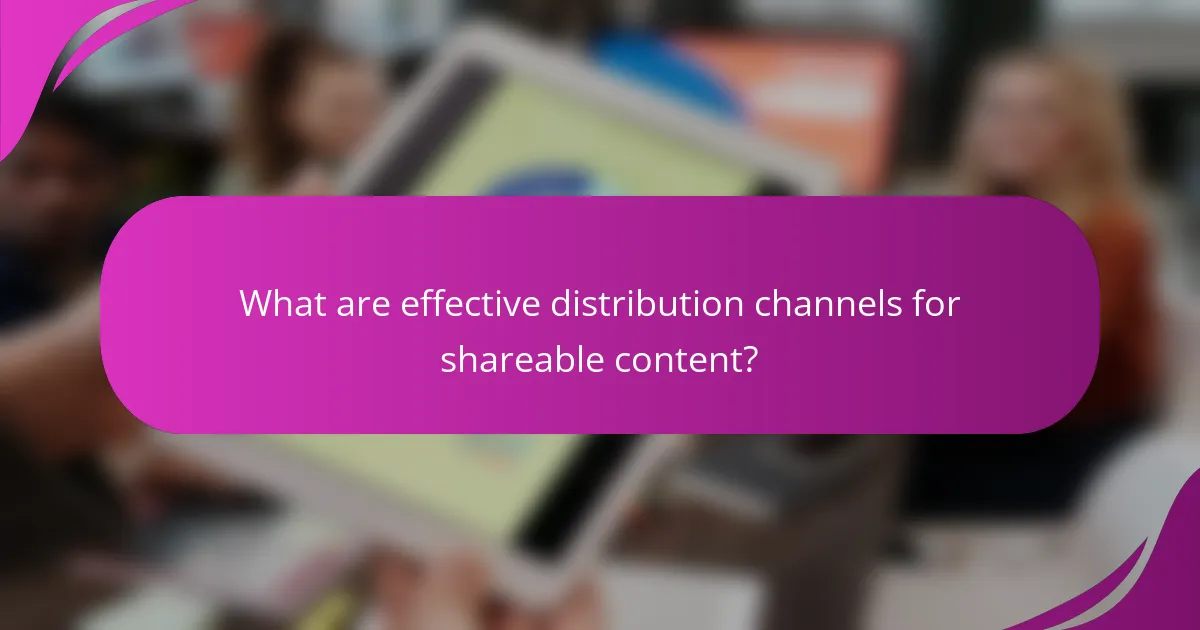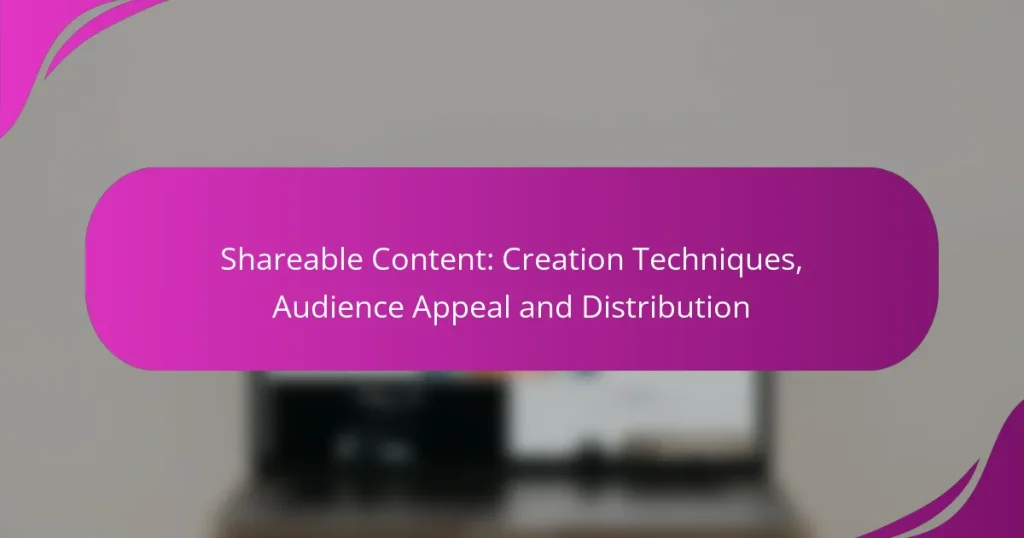Creating shareable content requires a deep understanding of your audience’s preferences and cultural context, particularly in diverse regions like South Africa. By focusing on engaging storytelling and appealing visuals, you can craft content that resonates emotionally and aligns with their interests. Additionally, leveraging effective distribution channels such as social media, email marketing, and influencer partnerships can significantly enhance your content’s reach and engagement.

How to create shareable content in South Africa?
Creating shareable content in South Africa involves understanding local preferences and cultural nuances. Focus on engaging storytelling, appealing visuals, and leveraging social media to resonate with your audience.
Engaging storytelling techniques
Effective storytelling captivates audiences and encourages sharing. Use relatable characters, compelling narratives, and emotional connections to draw readers in. For example, local success stories or anecdotes that reflect South African culture can enhance relatability.
Consider using the “hero’s journey” framework, where the audience identifies with a protagonist overcoming challenges. This technique can create a deeper connection and motivate sharing among peers.
Visual content strategies
Visuals play a crucial role in making content shareable. Use high-quality images, infographics, and videos to convey messages quickly and effectively. South Africans respond well to vibrant colors and culturally relevant imagery.
Incorporate visual storytelling by creating slideshows or short videos that summarize key points. This not only enhances engagement but also increases the likelihood of shares on platforms like Facebook and Instagram.
Utilizing user-generated content
User-generated content (UGC) can significantly boost shareability. Encourage your audience to share their experiences related to your brand, which can be showcased on your platforms. This fosters community and trust, making content more relatable.
Run contests or campaigns that invite users to submit their content, such as photos or testimonials. Highlighting these contributions can create a sense of ownership and encourage further sharing among their networks.
Leveraging social media trends
Staying updated with social media trends is essential for creating shareable content. Monitor popular hashtags, challenges, and viral topics within South Africa to align your content with current interests.
Participate in trending conversations by creating relevant content that adds value. This can include memes, challenges, or commentary that resonates with local audiences, increasing the chances of shares and engagement.
Incorporating interactive elements
Interactive elements enhance user engagement and encourage sharing. Consider adding polls, quizzes, or interactive infographics to your content. These features invite users to participate actively, making the experience more memorable.
For instance, a quiz that relates to South African culture or current events can spark interest and sharing among friends. Ensure that these elements are easy to use and mobile-friendly, as many users access content via smartphones.

What makes content appealing to audiences?
Content becomes appealing to audiences when it resonates emotionally, aligns with their interests, and reflects their cultural context. Understanding these factors can significantly enhance engagement and shareability.
Understanding audience demographics
Audience demographics include age, gender, income level, education, and geographic location. Tailoring content to these characteristics helps ensure it meets the specific needs and preferences of different groups. For instance, younger audiences may prefer quick, visually engaging formats, while older demographics might favor in-depth articles.
Utilizing tools like surveys or analytics can provide insights into your audience’s demographic profile. This data can guide content creation, ensuring it is relevant and appealing to the intended viewers.
Emotional resonance in content
Emotional resonance occurs when content evokes feelings that connect with the audience on a personal level. This can be achieved through storytelling, relatable scenarios, or addressing common challenges. Content that stirs emotions is more likely to be shared and remembered.
Consider using narratives that highlight triumphs or struggles, as these often elicit empathy and connection. For example, a brand sharing customer success stories can create a strong emotional bond with its audience.
Relevance to local culture
Content that reflects local culture resonates more deeply with audiences. This includes using culturally relevant references, language, and humor that align with the audience’s everyday experiences. For example, a marketing campaign in Spain might incorporate local festivals or traditions to engage effectively.
Researching cultural norms and values is essential when creating content for specific locales. This ensures that the messaging is not only appropriate but also appealing, enhancing the likelihood of sharing and engagement.

What are effective distribution channels for shareable content?
Effective distribution channels for shareable content include social media platforms, email marketing, and influencer partnerships. Each channel has unique strengths and can significantly enhance the reach and engagement of your content.
Social media platforms in South Africa
In South Africa, popular social media platforms like Facebook, Instagram, and Twitter are essential for distributing shareable content. These platforms allow for targeted advertising and organic reach, enabling brands to engage with specific demographics effectively.
When using social media, consider the timing of your posts. Research indicates that posting during peak hours can increase visibility and interaction rates. Engaging visuals and concise messaging are crucial for capturing attention in a crowded feed.
Email marketing strategies
Email marketing remains a powerful tool for distributing shareable content. Crafting compelling subject lines and personalized messages can significantly improve open rates and engagement. Segmenting your audience based on interests or behaviors can further enhance effectiveness.
To maximize impact, include clear calls to action that encourage recipients to share the content with their networks. Regularly testing different formats and content types can help identify what resonates best with your audience.
Influencer partnerships
Collaborating with influencers can amplify the reach of your shareable content. Influencers often have established trust with their followers, making their endorsements particularly valuable. Choose influencers whose audience aligns with your target market for the best results.
When forming partnerships, ensure that the content created feels authentic and aligns with the influencer’s style. This authenticity can lead to higher engagement rates and more shares, ultimately expanding your content’s reach.

What criteria should be considered for content creation?
When creating content, it’s essential to consider factors such as audience relevance, clarity of purpose, and distribution methods. These criteria ensure that the content resonates with the intended audience and achieves its goals effectively.
Defining target audience
Understanding your target audience is crucial for effective content creation. Identify demographics such as age, gender, interests, and location to tailor your message appropriately. For example, content aimed at young adults may use informal language and trending topics, while material for professionals might focus on industry insights.
Utilize tools like surveys or social media analytics to gather data about your audience. This information helps you create content that meets their needs and preferences, increasing engagement and shareability.
Setting clear objectives
Establishing clear objectives is vital for guiding your content creation process. Determine what you want to achieve, whether it’s increasing brand awareness, driving website traffic, or generating leads. Specific goals help measure success and inform content strategies.
Use the SMART criteria—Specific, Measurable, Achievable, Relevant, and Time-bound—to frame your objectives. For instance, instead of a vague goal like “increase engagement,” aim for “boost social media shares by 20% in three months.” This clarity allows for focused content development and evaluation.

How to measure the success of shareable content?
Measuring the success of shareable content involves analyzing various metrics that indicate audience engagement and reach. Key performance indicators such as engagement rates, shares, and overall reach provide insights into how well the content resonates with the audience.
Engagement metrics analysis
Engagement metrics are crucial for understanding how users interact with your content. Key metrics include likes, comments, and time spent on the page. A high engagement rate often indicates that the content is relevant and appealing to the audience.
To effectively analyze engagement, consider using tools like Google Analytics or social media insights. Look for patterns over time, such as spikes in engagement following specific campaigns or content types. This can help you refine your content strategy.
Tracking shares and reach
Tracking shares and reach helps quantify how far your content spreads across social platforms and the web. Shares indicate how many times users have distributed your content, while reach measures the total number of unique users who have seen it. Both metrics are essential for assessing the viral potential of your content.
Utilize social media analytics tools to monitor shares and reach. Aim for a balance between organic shares and paid promotions to maximize visibility. Regularly review these metrics to identify successful content types and adjust your strategy accordingly.

What are the emerging trends in content creation?
Emerging trends in content creation focus on leveraging technology and audience engagement to enhance quality and reach. Key developments include the rise of AI-generated content tools, interactive formats, and personalized experiences that cater to specific audience preferences.
AI-generated content tools
AI-generated content tools are software applications that utilize artificial intelligence to create written, visual, or audio content. These tools can produce articles, social media posts, and even videos in a fraction of the time it would take a human, making them increasingly popular among marketers and content creators.
When using AI content tools, consider the quality of the output and the need for human oversight. While these tools can generate content quickly, they may lack the nuance and creativity that a human touch provides. It’s essential to review and edit AI-generated content to ensure it aligns with your brand voice and messaging.
Examples of popular AI content tools include Jasper, Copy.ai, and Writesonic. These platforms often offer subscription models, typically ranging from $20 to $100 per month, depending on the features and usage limits. Be mindful of the potential for plagiarism and ensure that your final content is original and compliant with copyright regulations.


